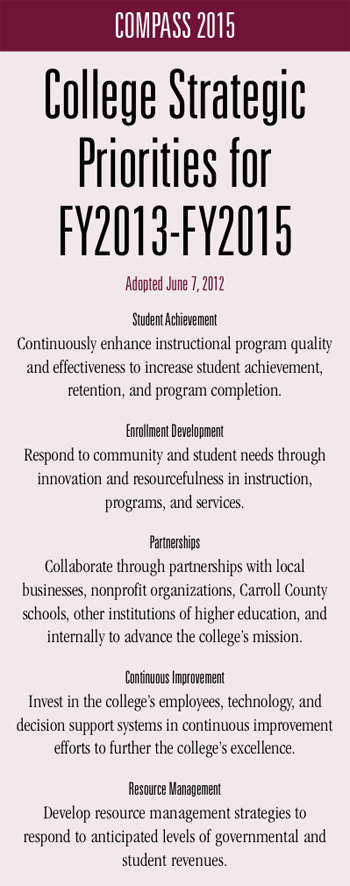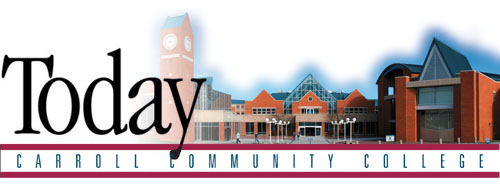 |
On June 7, 2012, at a meeting of the Planning Advisory Council, college president Dr. Faye Pappalardo announced Compass 2015, the college's strategic priorities for the three-year period encompassing fiscal years 2013 through 2015.
Planning at Carroll Community College is founded upon the college's mission and guided by the priorities in Compass. The prior Compass, created in 2005, ended with fiscal year 2012. In February the President charged the Planning Advisory Council with developing recommendations for Compass 2015.
Mission Statement Revision
During the college's self-study in preparation for the Middle States reaccreditation visit in April 2011, College President Dr. Faye Pappalardo determined that a comprehensive, college-wide review of the institution's mission was warranted. Dr. Pappalardo appointed a committee to develop recommendations for revising the Mission Statement. The 12-person committee represented all areas of the college and included the chair of the Board of Trustees.
The committee involved the entire campus community during its deliberations. The committee presented its recommendation to the Planning Advisory Council in an open meeting on November 21, 2011. With one amendment, the Council unanimously endorsed the proposal and forwarded it to the President.
The President presented the new Mission Statement to the Board of Trustees, and it was unanimously approved by the Board on February 15, 2012. After adoption of the new Mission Statement, the President charged the Planning Advisory Council to serve as the steering committee for preparation of the college's next set of multi-year strategic priorities, Compass 2015.
Environmental Scanning
During February, March, and April 2012, the Planning Advisory Council hosted a number of environmental scanning presentations to gather information about the college, Carroll County, and surrounding region, plus pertinent national and global issues. After a situation analysis describing several aspects of the college's current status and performance, presentations were heard on the college's financial outlook, technology trends on and off campus, regional occupational demand, and instructional programming trends. Dr. Freeman Hrabowski, president of the University of Maryland Baltimore County, and Anirban Basu, noted local economist and CEO of the Sage Policy Group, delivered speeches in the college theater sharing their views on the education needed for careers of the future and the local and national economic outlook.
Employee Survey
In May 2012, all college employees were invited, through an online survey, to express their opinions about 50 of the environmental scanning factors identified by the Planning Advisory Council, and to suggest priorities for the college over the next three years. A total of 118 employees responded.
Employees identified county budget deficits, shifting of pension costs from the state to the county, and declining county and state aid per student as major threats.
Threats or vulnerabilities rated somewhat lower included student progress through their developmental course sequence, funding to maintain campus technology, employee dissatisfaction with current salaries, limited course availability, declining enrollment, full-time faculty teaching less than 50% of classes, and anticipated tuition increases.
The respondents identified a number of major strengths of the college, including the quality of instruction, comparatively low tuition, high pass rates of our Nursing students on their licensure exams, campus technology, the college's current market shares of full-time and part-time students, high student retention rates, and an average class size below 20 students. Major opportunities included projected middle-skill job openings in the region, the need for postsecondary education for most jobs nationally, and the documented economic value of the Associate's degree.
Other strengths included the campus culture, performances and exhibitions by our Fine Arts Department, the college's institutional effectiveness and student learning outcomes assessment program, the college's cost efficiency, and low employee turnover. Other external positives included the need for workers to "reconfigure" their careers over their lifetimes, the new statewide broadband network, the Carroll Business Path and its focus in the Miller Center for Small Business, and job growth associated with Base Realignment and Closure.
After rating the likely impact of the 50 environmental opportunities and threats, and institutional strengths and weaknesses, employees provided their suggestions for college priorities in response to an open-ended survey question. Employees provided a wide range of suggestions; content analysis by Institutional Research identified over 40 different areas of interest, although many were mentioned only once. Five major themes stood out, with multiple mentions: increasing student retention and program completion, with a focus on developmental education; maintaining quality through investment in employees, campus technology, and decision-support systems; enrollment development by emphasizing career programs and online course delivery appealing to adults; partnerships with local businesses, the Carroll County Public Schools, and other institutions of higher learning; and developing alternative funding sources to supplement governmental and student revenues.
Planning Advisory Council College Priorities Workshop
The findings from the employee survey were shared in a collegewide email on May 4, 2012. The email provided links to the detailed survey data and the PowerPoint presentations of environmental scanning information available on college websites, and invited employees to the May 7, 2012 meeting of the Planning Advisory Council. The sole agenda item of the meeting was to develop preliminary statements of campus priorities for the next three years. Attendees were provided the employee survey data and summaries, a copy of the college's recommendations contained in its Middle States Self Study report from April 2011, and an overview of the college's planning processes.
In an appreciative inquiry framework, attendees at the May 7th Planning Advisory Council meeting were asked first to identify those qualities that make the college successful, and then to suggest 3 to 5 priorities with the greatest potential to make Carroll Community College the most effective, energizing, and fun place to work and learn. Qualities contributing to the college's success mentioned most often were its dedicated and caring faculty and staff, the high quality of instruction, the college's affordable tuition, the diversity of programs offered, and campus technology. Priorities for FY2013-FY2015 garnering the most mentions in this exercise were to continue placing student needs first in all our decisions; offer new programs to serve the County and generate enrollment; invest in and support the college's dedicated and innovative faculty and staff; maintain currency in campus instructional and administrative technology; keep tuition affordable; and seek alternative funding to support investment in employees and to moderate tuition increases.
Following the appreciative inquiry exercise, workshop attendees split into four groups to begin conceptualizing Compass 2015 priority statements. At the conclusion of the workshop, each group reported out on its deliberations, during which the attendees offered comments. The group recommendations and ensuing suggestions were captured in a projected Word document, which served as the basis for drafting the first proposed set of Compass 2015 strategic priorities. The draft was reviewed by the President and Executive Team, and then shared with the faculty on May 11, 2012. Further review and revision yielded a revised set of five priorities, which was forwarded to the college president.
Annual Strategic Planning
With the president's announcement of the Compass 2015 priorities on June 7th, the framework was set to develop the college's FY2013 Strategic Plan. The annual strategic plans identify the specific initiatives the college will focus on during a given fiscal year. The FY2013 Strategic Plan will be highlighted in the Convocation 2012 issue of Today.

Back to top
|
|

